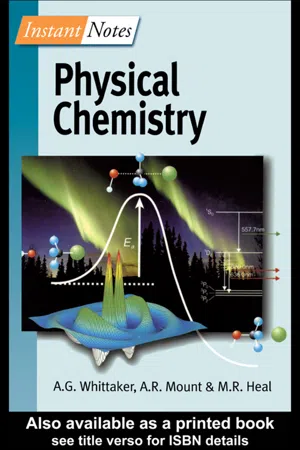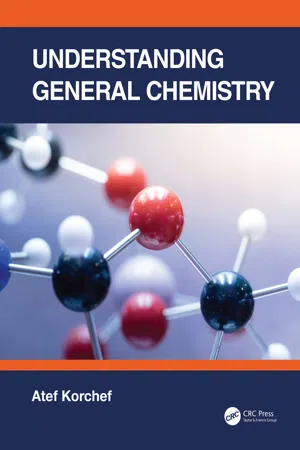Enthalpy of Reaction
The enthalpy of reaction is the heat change that occurs during a chemical reaction at constant pressure. It is represented by the symbol ΔH and can be exothermic (releasing heat) or endothermic (absorbing heat). The enthalpy of reaction is a key concept in understanding the energy changes associated with chemical reactions.
8 Key excerpts on "Enthalpy of Reaction"
- eBook - ePub
- Gavin Whittaker, Andy Mount, Matthew Heal(Authors)
- 2000(Publication Date)
- Taylor & Francis(Publisher)
...The enthalpy change, ΔH, for finite changes at constant pressure is given by the expression Δ H =Δ U + p V, so making the enthalpy change for a process equal to the heat exchange in a system at constant pressure. For a chemical system which releases or absorbs a gas at constant pressure, the enthalpy change is related to the internal energy change by Δ H =Δ U +Δ n.RT, where Δ n is the molar change in gaseous component. Properties of Enthalphy Enthalpy is a state function whose absolute value cannot be known.Δ H can be ascertained, either by direct methods, where feasible, or indirectly. An increase in the enthalpy of a system, for which Δ H is positive, is referred to as an endothermic process. Conversely, loss of heat from a system, for which Δ H has a negative value, is referred to as an exothermic process. The enthalpy change arising from a temperature change at constant pressure is given by the expression Δ H = C p Δ T, providing that C p does not appreciably change over the temperature range of interest. Where Cp does change, the integral form of the equation, is used. In a chemical reaction, the enthalpy change is equal to the difference in enthalpy between the reactants and products: Kirchhoff’s law The value of ΔH for a reaction varies considerably with temperature. Kirchhoff’s s equation, derived from the properties of enthalpy, quantifies this variation. Where C p does not appreciably change over the temperature range of interest, it may be expressed in the form Δ H T2 -Δ H T1 =Δ C p Δ T, or as, where Δ C p is a function of temperature. Related topics The first law (B1) Entropy and change (B5) Thermochemistry (B3) Free energy (B6) Entropy () Statistical thermodynamics (G8) Enthalpy The majority of chemical reactions, and almost all biochemical processes in vivo, are performed under constant pressure conditions and involve small volume changes...
- Kevin Reel, Derrick C. Wood, Scott A. Best(Authors)
- 2014(Publication Date)
- Research & Education Association(Publisher)
...According to the first law of thermodynamics, heat lost by a hotter object is gained by a colder object. In contrast, enthalpy (H) refers to the energy released or absorbed by a chemical reaction. Unless there is pressure–volume (PΔV) work performed by the system, changes in enthalpy (ΔH) are essentially the same as the heat exchanged during a reaction. ΔH is the difference between the enthalpy of the products and the enthalpy of the reactants. Exothermic processes describe a heat transfer from the system into the surroundings. Heat is given off during an exothermic reaction (ΔH < 0) and the products of the reaction have less enthalpy than the reactants. Endothermic processes undergo a transfer of energy from the surroundings into the system. Heat is absorbed during an endothermic reaction (ΔH > 0), because energy must be put into the reaction to move it from reactants to products. The products of the reaction have more enthalpy than the reactants. Energy diagrams for exothermic and endothermic reactions can be found in Chapter 11, Kinetics. Heat Capacity, Specific Heat, and Units Heat capacity is a measure of how much an object changes temperature when a given amount of heat is absorbed. For example, when a metal pan is placed on a stovetop it only takes a few moments for the pan to get really hot. This is because metals have a low heat capacity. The units for heat capacity are in J/°C (J/K) as determined by the equation: Specific heat (c) is related to heat capacity because it defines the quantity of heat required to raise 1 gram of substance by 1°C (or 1 Kelvin). The energy unit of the calorie was originally defined in the early 1800s from the specific heat of water, which is the amount of energy required to raise 1 gram of water by 1°C. Of course, calories are not the same as Calories. The “food calorie” is sometimes written with the capital “C” and is actually kilocalories. Since then, scientists have embraced the SI unit of the Joule for measuring heat...
- eBook - ePub
- Jeffrey Gaffney, Nancy Marley(Authors)
- 2017(Publication Date)
- Elsevier(Publisher)
...In a physical sense, it can be viewed as the energy required to create the system at equilibrium (internal energy) plus the amount of energy required to create space for the system by expanding its volume against a constant pressure (PV). This new state function allows us to be able to predict the changes in energy for chemical reactions at constant pressure. Although the value of enthalpy for an equilibrium state cannot be calculated directly, the change in enthalpy (Δ H) between equilibrium states can be calculated and is given by; Δ H = Δ E + Δ PV = q + w + Δ PV (9) For chemical reactions at constant pressure, where the only work done by the system is pressure-volume work, w p is equal to − P Δ V and the change in enthalpy becomes; Δ H p = q p – P Δ V + P Δ V Δ H p = q p (10) So, for the condition of constant pressure, the change in enthalpy is simply equal to the heat transferred to or from the system (q p). Similar to Δ E v, Δ H p will also be negative for exothermic reactions as the heat released. at constant pressure will move to the surroundings from the system, and Δ H p will be positive for endothermic reactions when heat must be supplied to the system for the reaction to occur. Heat capacities are also most important under conditions of constant pressure since most materials and chemical species are used under these conditions. The specific heat capacity of a substance under conditions of constant pressure (C p) is related to the change in internal energy as; C p = q p / m Δ T = Δ H p / m Δ T (11) Changes in enthalpy are also associated with the phase transitions discussed in Chapter 1. Since phase transitions are caused by heat added to or released from a system at constant pressure, they are accompanied with a change in enthalpy according to Eq. (10). The enthalpy changes that occur in each phase transition are related to each other as shown in Fig. 8.3. The length of the arrows in Fig...
- eBook - ePub
- Antonio Blanco, Gustavo Blanco(Authors)
- 2017(Publication Date)
- Academic Press(Publisher)
...This is the effect produced by the catalysts, which increase the rate of the activated intermediate formation by reducing the activation energy. In the mechanical analogy, the action of a catalyst consists in decreasing the height of the initial rise in the ground. Then, a small impulse will be sufficient for the ball to start rolling. Fig. 7.2 shows curves for the energy changes in a reaction without and with the aid of a catalyst. While a catalyst increases the reaction rate, it does not alter the net energy change; the value of ∆ G and the equilibrium constant are unchanged whether the reaction is catalyzed or not. Summary Thermodynamics is the branch of physics that deals with energy and its transformations. Energy changes in biochemical reactions obey fundamental principles of thermodynamics, are expressed in two laws: First law. The total energy of the universe remains constant. Second law. The entropy of the universe increases. Energy changes occur in chemical transformations. Heat is one of the most common forms of energy and it is easy to measure. At constant pressure and temperature, the change in heat is the change in enthalpy (∆ H). Energy change (∆ E) equals ∆ H when no work is produced in the system. Free energy (G) is the fraction of released energy available to perform work. Free energy change (∆ G) of a reaction is given by the equation: ∆ G = ∆ H – T · ∆ S. T is absolute temperature and ∆ S, entropy change, corresponding to energy that is not available to perform work. Open system...
- eBook - ePub
- Atef Korchef(Author)
- 2022(Publication Date)
- CRC Press(Publisher)
...They release energy. 13. A phase change occurs when we cross the lines or the curves on the phase diagram. The temperature remains constant during a phase change (Figure 5.9) and energy is used to overcome attractive forces between molecules. 14. For a chemical reaction, when Δ H rxn < 0 the reaction is exothermic, when Δ H rxn > 0 the reaction is endothermic and when Δ H rxn = 0 the reaction is athermic (no heat is gained or lost). 15. The standard enthalpy of formation, designated by Δ H f °, is the change in enthalpy when one mole of a substance is formed under standard conditions (P = 1 atm and T = 25°C) from its pure elements under the same standard conditions. Conventionally, the standard enthalpy of formation of a pure element in its most stable form is zero. 16. Bond breaking requires energy. The energy required to break one mole of that chemical bond is called the bond enthalpy or bond dissociation enthalpy. It is also a measure of the bond strength. Bond enthalpy values are always positive since bond breaking is an endothermic process. However, bond making is an exothermic process (it releases energy). Note that a chemical reaction can be described as the breaking of bonds in the reactants and the making of bonds in the products. Thus, if the bond enthalpies of the reactants and products are known, we can calculate the standard enthalpy of the reaction, Δ H rxn ° : Δ H rxn ° = ∑ Δ H broken bonds − ∑ Δ H formed bonds 17. Hess’s law states that, if a chemical reaction is carried out in a series of steps, the enthalpy change ΔH for the overall reaction is equal to the sum of the enthalpy changes for the individual steps...
- eBook - ePub
MWH's Water Treatment
Principles and Design
- John C. Crittenden, R. Rhodes Trussell, David W. Hand, Kerry J. Howe, George Tchobanoglous(Authors)
- 2012(Publication Date)
- Wiley(Publisher)
...The difference between the actual state and the equilibrium state is the driving force for many processes and reactions. Equilibrium thermodynamics can be used to determine whether the treatment process is feasible, and the reaction kinetics, described in the following sections, will provide a basis for the treatment device size. To determine whether a reaction will proceed (i.e., is thermodynamically favorable), two fundamental thermodynamic criteria must be considered. The first thermodynamic criterion that must be satisfied is that the change in entropy of the system and its surroundings must be greater than zero for a reaction to proceed. When evaluating chemical reactions, the entropy requirement is typically satisfied, especially when heat is produced by the reaction and, therefore, is not considered further in this text. The second thermodynamic criterion necessary for a reaction to proceed is the requirement that the change in free energy (final energy state minus initial energy state) of the reaction must be less than zero. Reference Conditions To understand how the free energy of reaction changes as a reaction proceeds, it is useful to examine the total free energy of reaction as a function of the reaction extent, as shown on Fig. 5.2. Because the absolute free energy of reaction cannot be determined easily, it is most common to determine the change in free energy of a reaction. The free energy of the reaction curve shown on Fig. 5.2 is compared to a convenient set of standard conditions. For example, a common definition of standard conditions is as follows: (1) solids, liquids, and gases in their lowest energy state at 1 atm (or 1 bar); (2) solutes in solution referenced to a 1 molal hydrogen ion concentration; and (3) a specified temperature, usually 25°C...
- eBook - ePub
- Warren C. Strahle, William A. Sirignano, William A. Sirignano(Authors)
- 2020(Publication Date)
- Routledge(Publisher)
...That is, which is the same as in the previous calculation. To generalize the steps above, the enthalpy for any substance i is written as (2.8) where the difference between the first two terms on the right side is called the sensible enthalpy and the last term is, of course, the heat of formation. This nomenclature is somewhat confusing, since Eq. (2.8) is an identity. The last two terms are, in fact, equal, but convention gives them different symbols. Shown here is the reference temperature of 298 K. Any other temperature could have been chosen, but the JANNAF Tables make the use of 298 K most convenient. The reader should verify that the placement of Eq. (2.8) in Eq. (2.7) will reproduce the numerics of the example. Example 2.1. In the hydrogen—fluorine case above, calculate the heat added if the process path follows (a) heating of the reactants from 200 K to 2000 K at the pressure of 5 bar, and then (b) conversion to product at 5 bar. and 2000 K. Solution. From the tables in Appendix A: For process (a) For process (b) Consequently, Qp = 60.75−277.57 = −216.83 kJ. Generalizing what we have done if there are M different species in both the reactants and products, the heat evolved in a constant pressure process is (2.9) FIGURE 2.3e. Illustration of equilibria. where the index j denotes products and the index i denotes reactants. Similarly, for a constant volume process the heat evolved is (2.10) where the energy for any species is obtained from the enthalpy by E i = H i− p/c i. Before proceeding to the use of the constant pressure and constant volume heat expressions, some miscellaneous comments should be made. In the hydrogen, fluorine example, the fact is that these two reactants cannot coexist in a vessel under the stated conditions. They would immediately ignite and form the product upon coming into contact with each other. The mixture is called hypergolic when ignition is spontaneous...
- eBook - ePub
- Adrian Dingle, Derrick C. Wood(Authors)
- 2014(Publication Date)
- Research & Education Association(Publisher)
...mass, c is the specific heat capacity of the substance being heated, and Δ T is the temperature change. vii. A plateau region represents a stage where two phases are in equilibrium with one another. Where the gas is condensing, the amount of energy that is removed can be calculated using q = (ΔH vaporization)(moles). Where the liquid is freezing, the amount of energy that is removed can be calculated using q = (ΔH fusion)(moles). These are exothermic processes because energy must be removed. III. Calorimetry A. Calorimetry is an experimental technique used to measure the change in energy of a chemical reaction or phase change. 1. General principles: Put a chemical reaction or phase change in contact with a heat bath (usually water). We can measure the change in temperature of the heat bath. Knowing the heat capacity of the heat bath, we can calculate the energy change in the heat bath by applying: The energy change in the heat bath will be the same magnitude in energy as the chemical reaction or phase change, just with the opposite sign. If the heat bath gains energy, its temperature goes up, meaning the energy of the chemical reaction or phase change went down (it lost energy) and vice versa. Enthalpy changes where energy is released are exothermic and have negative values. Enthalpy changes where energy is absorbed are end othermic and have positive values. 2. Coffee cup calorimeter—Styrofoam cups are commonly used as insulators in the high school chemistry lab, to measure temperature changes without a loss of energy to the surroundings. Practice Question 1. If 5.00 g of urea are added to 90.00 g of water in a coffee cup calorimeter, the temperature of the contents of the cup falls by 3.100 o C...







